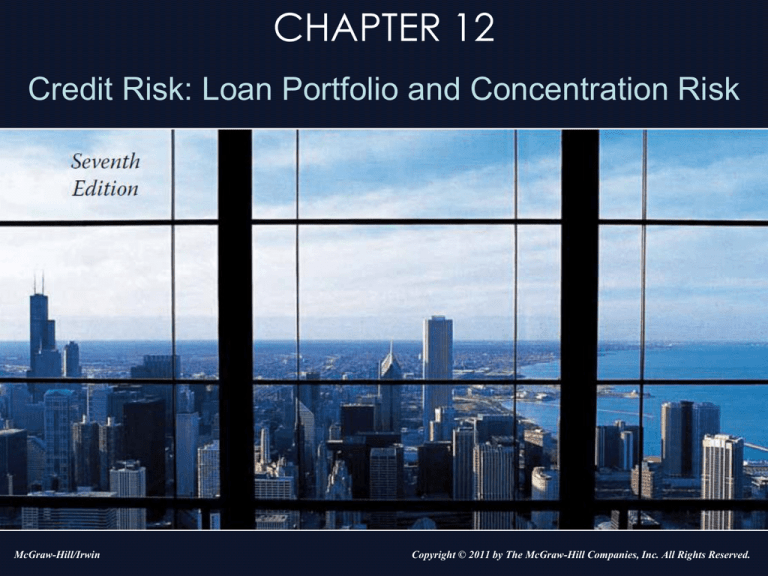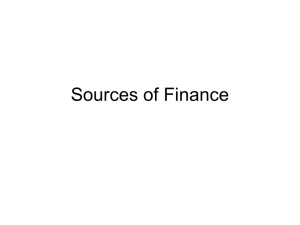
CHAPTER 12
Credit Risk: Loan Portfolio and Concentration Risk
McGraw-Hill/Irwin
Copyright © 2011 by The McGraw-Hill Companies, Inc. All Rights Reserved.
Overview
This chapter discusses the
management of credit risk in a loan
(asset) portfolio context. It also
discusses the setting of credit exposure
limits to industrial sectors and regulatory
approaches to monitoring credit risk.
The National Association of Insurance
Commissioners has also developed
limits for different types of assets and
borrowers in insurers’ portfolios.
12-2
Simple Models of Loan Concentration
Migration analysis
– Track credit rating changes within sector or
pool of loans
– Rating transition matrix reflects history of
ratings changes
Widely applied to commercial loans,
credit card portfolios, and consumer
loans
12-3
Web Resources
For information on migration analysis,
visit:
Standard & Poors
www.standardandpoors.com
Moody’s www.moodys.com
12-4
Rating Transition Matrix
Risk grade:
beginning
of year
Risk grade: end of year
1
2
3
Default
1| .85 .10 .04 .01
2| .12 .83 .03 .02
3| .03 .13 .80 .04
12-5
Simple Models of Loan Concentration
Concentration limits
– On loans to individual borrower
– Concentration limit = maximum loss loss
rate
Maximum loss expressed as percent of capital
– Some countries, such as Chile, specify limits
by sector or industry
– FIs typically set geographic concentration
limits
12-6
Diversification & Modern Portfolio Theory
Applying portfolio theory to loans
– Using loans to construct the efficient
frontier
– Minimum risk portfolio
Low risk
Low return
12-7
FI Portfolio Diversification
12-8
Applying Portfolio Theory to Loans
Requires:
– (i) Expected return on loan (typically
measured by the all-in-spread)
– (ii) Loan risk
– (iii) Correlation of loan default risks
12-9
Modern Portfolio Theory
Expected Return:
n
R p X i Ri
Variance:
i 1
n
n
n
X X i X j i , j
2
p
i 1
n
2
i
2
i
i 1 j 1
n
X i X j i , j i j
i 1 j 1
12-10
Moody’s KMV Portfolio Manager Model
KMV measures these as follows:
Ri = AISi - E(Li) = AISi - [EDFi × LGDi]
i = ULi = Di × LGDi = [EDFi(1-EDFi)]½ × LGDi
ij = correlation between systematic
return components of equity returns
of borrower i and borrower j
12-11
KMV Asset Level Correlation
12-12
Partial Applications of Portfolio Theory
Loan volume-based models
– Commercial bank call reports
Can be aggregated to estimate national
allocations
– Shared national credit
National database that breaks commercial
and industrial loan volume into 2-digit SIC
codes
12-13
Partial Applications
Loan volume-based models
– Provide market benchmarks
Standard deviation measure of individual FI’s
loan allocations deviation from the benchmark
allocations
N
j
2
(
X
X
)
i, j
i
i 1
N
12-14
Loan Loss Ratio-Based Models
Estimate loan loss risk by SIC sector
– Time-series regression:
[sectoral losses in ith sector]
[ loans to ith sector ]
= a + bi [total loan losses]
[ total loans ]
12-15
Regulatory Models
Credit concentration risk evaluation largely
subjective and based on examiner
discretion
– Quantitative models were rejected by regulators
because the methods were not sufficiently
advanced and available data were not
sufficient
Life and PC insurance regulators propose
limits on investments in securities or
obligations of any single issuer
– General diversification limits
12-16
Pertinent Websites
Bank for International
Settlements
Federal Reserve
Bank
Moody’s
Moody’s KMV
National Association
of Insurance
Commissioners
Standard & Poors
www.bis.org
www.federalreserve.gov
www.moodys.com
www.moodyskmv.com
www.naic.org
www.standardandpoors.com
12-17
*CreditMetrics
If next year is a bad year, how much
will I lose on my loans and loan
portfolio?
VAR = P × 1.65 ×
Neither P, nor observed
Calculated using:
– (i)Data on borrower’s credit rating; (ii)
Rating transition matrix; (iii) Recovery rates
on defaulted loans; (iv) Yield spreads.
12-18
* Credit Risk+
Developed by Credit Suisse Financial
Products
– Based on insurance literature:
Losses reflect frequency of event and severity of loss
– Loan default is random
– Loan default probabilities are independent
Appropriate for large portfolios of small
loans
Modeled by a Poisson distribution
12-19
*Credit Risk+ Model: Determinants of Loan Losses
12-20











